Top Rankings
Frenchtown K-12 Schools School District ranks among the top 20% of public school district in Montana for:
Category
Attribute
Graduation Rate
Highest graduation rate (Top 1%)
Community Size
Largest student body (number of students) (Top 1%)
For the 2025 school year, there is 1 public preschool serving 439 students in Frenchtown K-12 Schools School District. This district's average pre testing ranking is 7/10, which is in the top 50% of public pre schools in Montana.
Public Preschool in Frenchtown K-12 School School District have an average math proficiency score of 52% (versus the Montana public pre school average of 41%), and reading proficiency score of 47% (versus the 47% statewide average).
Minority enrollment is 15% of the student body (majority Hispanic), which is less than the Montana public preschool average of 23% (majority American Indian).
Overview
This School District
This State (MT)
# Schools
5 Schools
395 Schools
# Students
1,385 Students
65,251 Students
# Teachers
100 Teachers
4,856 Teachers
Student : Teacher Ratio
14:1
14:1
District Rank
Frenchtown K-12 Schools School District, which is ranked within the bottom 50% of all 347 school districts in Montana (based off of combined math and reading proficiency testing data) for the 2021-2022 school year.
The school district's graduation rate of 95% has increased from 90-94% over five school years.
Overall District Rank
#179 out of 350 school districts
(Bottom 50%)
(Bottom 50%)
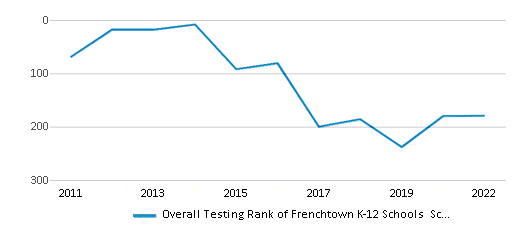
Math Test Scores (% Proficient)
34%
35%
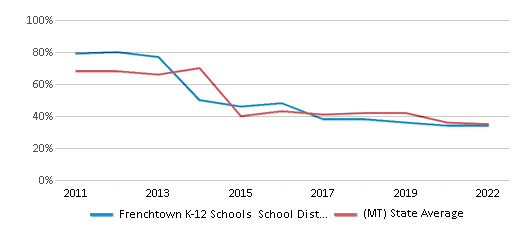
Reading/Language Arts Test Scores (% Proficient)
48%
46%
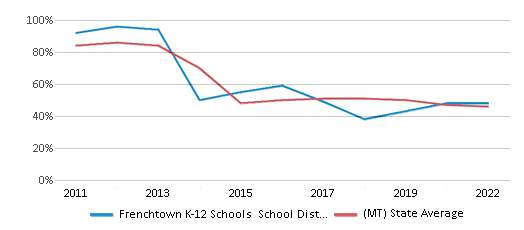
Science Test Scores (% Proficient)
30%
37%
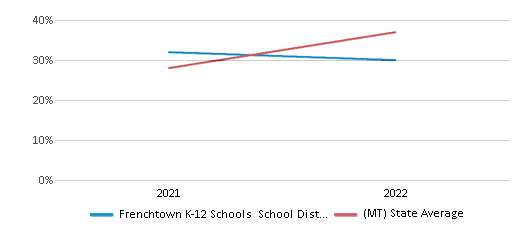
Graduation Rate
≥95%
86%
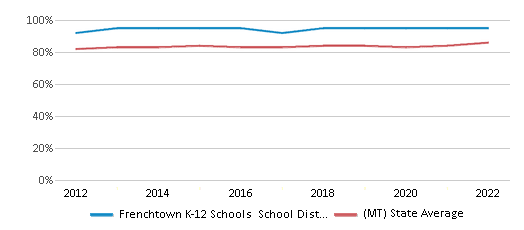
Students by Ethnicity:
Diversity Score
0.26
0.40
# American Indian Students
26 Students
6,505 Students
% American Indian Students
2%
10%
# Asian Students
18 Students
357 Students
% Asian Students
1%
1%
# Hispanic Students
69 Students
4,243 Students
% Hispanic Students
5%
6%
# Black Students
7 Students
459 Students
% Black Students
1%
1%
# White Students
1,190 Students
50,046 Students
% White Students
86%
77%
# Hawaiian Students
5 Students
111 Students
% Hawaiian Students
n/a
n/a
# Two or more races Students
70 Students
3,530 Students
% of Two or more races Students
5%
5%
Students by Grade:
# Students in PK Grade:
13
1,059
# Students in K Grade:
107
11,907
# Students in 1st Grade:
108
10,512
# Students in 2nd Grade:
119
10,623
# Students in 3rd Grade:
92
9,606
# Students in 4th Grade:
78
9,406
# Students in 5th Grade:
96
8,220
# Students in 6th Grade:
102
3,620
# Students in 7th Grade:
110
158
# Students in 8th Grade:
107
140
# Students in 9th Grade:
110
-
# Students in 10th Grade:
123
-
# Students in 11th Grade:
111
-
# Students in 12th Grade:
109
-
# Ungraded Students:
-
-
District Revenue and Spending
The revenue/student of $12,796 in this school district is less than the state median of $15,263. The school district revenue/student has stayed relatively flat over four school years.
The school district's spending/student of $11,348 is less than the state median of $15,352. The school district spending/student has stayed relatively flat over four school years.
Total Revenue
$18 MM
$2,285 MM
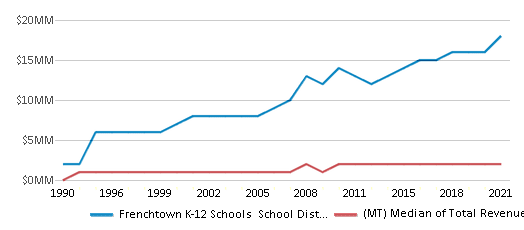
Spending
$16 MM
$2,298 MM
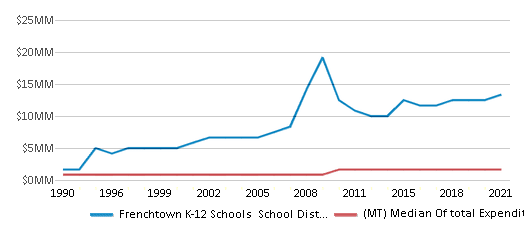
Revenue / Student
$12,796
$15,263
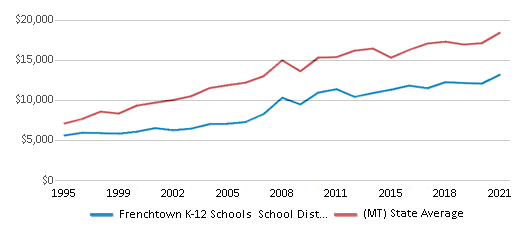
Spending / Student
$11,348
$15,352
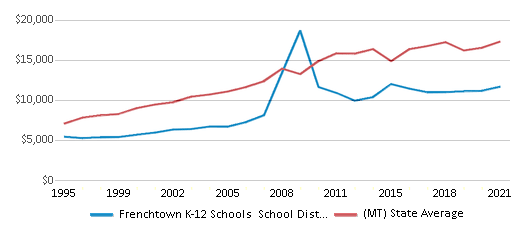
Best Frenchtown K-12 Schools School District Public Preschools (2025)
School
(Math and Reading Proficiency)
(Math and Reading Proficiency)
Location
Grades
Students
Rank: #11.
Frenchtown Elementary School
(Math: 50-54% | Reading: 45-49%)
Rank:
Rank:
7/
Top 50%10
16495 Main Street
Frenchtown, MT 59834
(406) 626-2620
Frenchtown, MT 59834
(406) 626-2620
Grades: PK-3
| 439 students
Recent Articles

Year-Round Or Traditional Schedule?
Which is more appropriate for your child? A year-round attendance schedule or traditional schedule? We look at the pros and cons.

Why You Should Encourage Your Child to Join a Sports Team
Participating in team sports has a great many benefits for children, there is no doubt. In this article you will learn what those benefits are.

White Students are Now the Minority in U.S. Public Schools
Increasing birth rates among immigrant families from Asia and Central and South America, combined with lower birth rates among white families, means that for the first time in history, public school students in the United States are majority-minority. This shift in demographics poses difficulties for schools as they work to accommodate children of varying language abilities and socio-economic backgrounds.





